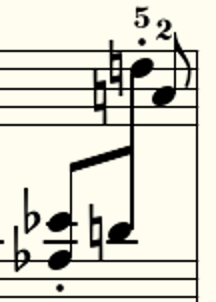The more things interact unnecessarily, the harder it becomes doing
things reliably. The more we manage to get LilyPond to behave to naive
expectations, the more useable power the average user has at their
convenience.
So we should not try overexercising the "music is complex, so LilyPond
can be expected to behave in unexpected ways" excuse more than
necessary. I don't have enough of an overview of the problem discussed
here to figure out whether this is the case here.
--
David Kastrup
Thanks for responding this thoughtfully. I may try to create a minimal example of this later.
In this case, the steps required weren’t obvious to naive expectations, but I don’t know if they could be made easier.
A construct like the following will, I think, always be an unusual one (ignore the bad spacing on the fingering, which I have’t yet fixed).

Why Bartók didn’t simply show the bottom D in the treble clef is an interesting question. I think he was trying to keep the relationship between the hands clear, but couldn’t quite include the upper D in a way that made sense without splitting it like this. Had he put the lower D in the treble clef where it more apparently belongs, it might have led to confusion about which hand was to play it.
But this is all speculation, and I’m not sure there actually is a naive way to expect this to work because it’s an unusual approach.
The two things in this that didn’t make sense naively are:
1. Why I couldn’t use something like " \once \override Stem.length = #8” in a set of beamed notes to adjust the length of the second stem, but this did work:
\stemUp \once \override Beam.positions = #'(7 . 8) <aes ees'>8-.[ d!8]
I’m sure there is a good reason for this, but that one really doesn’t work the way a naive user would expect.
2. Why a gap appeared in a complex example that didn’t appear in Kieren’s example (which is what necessitated the solution above). This is what I was referring to with the comment about various things interacting. But I suspect that it would be complex to find the source of that small gap, which persisted when I increased the stem length of the non-beamed note to try to make them meet. So I’m not worried here and I think no naive answer would be possible here just because this is weird, and trying to account for an unusual edge case like this probably isn’t worth the effort.
Best,
-Arle